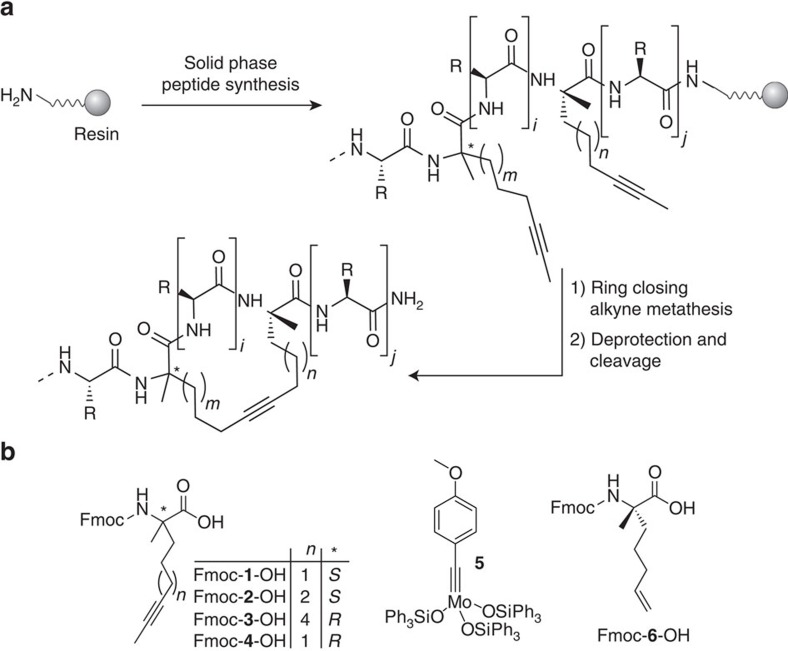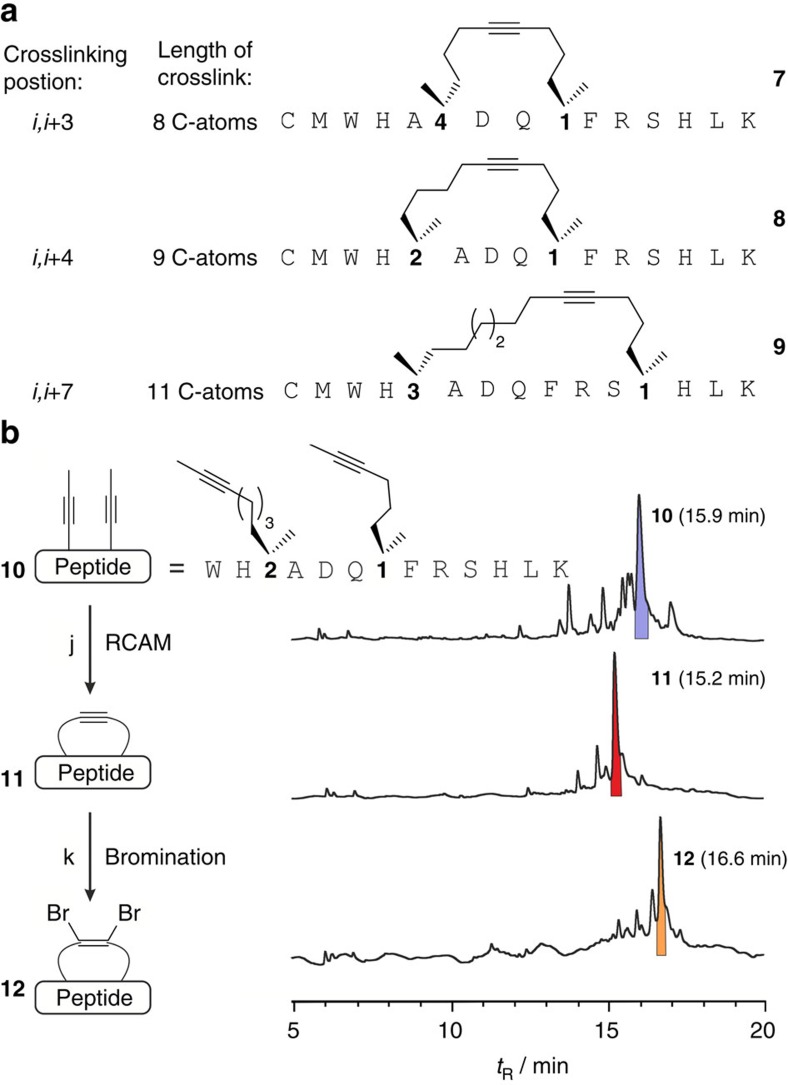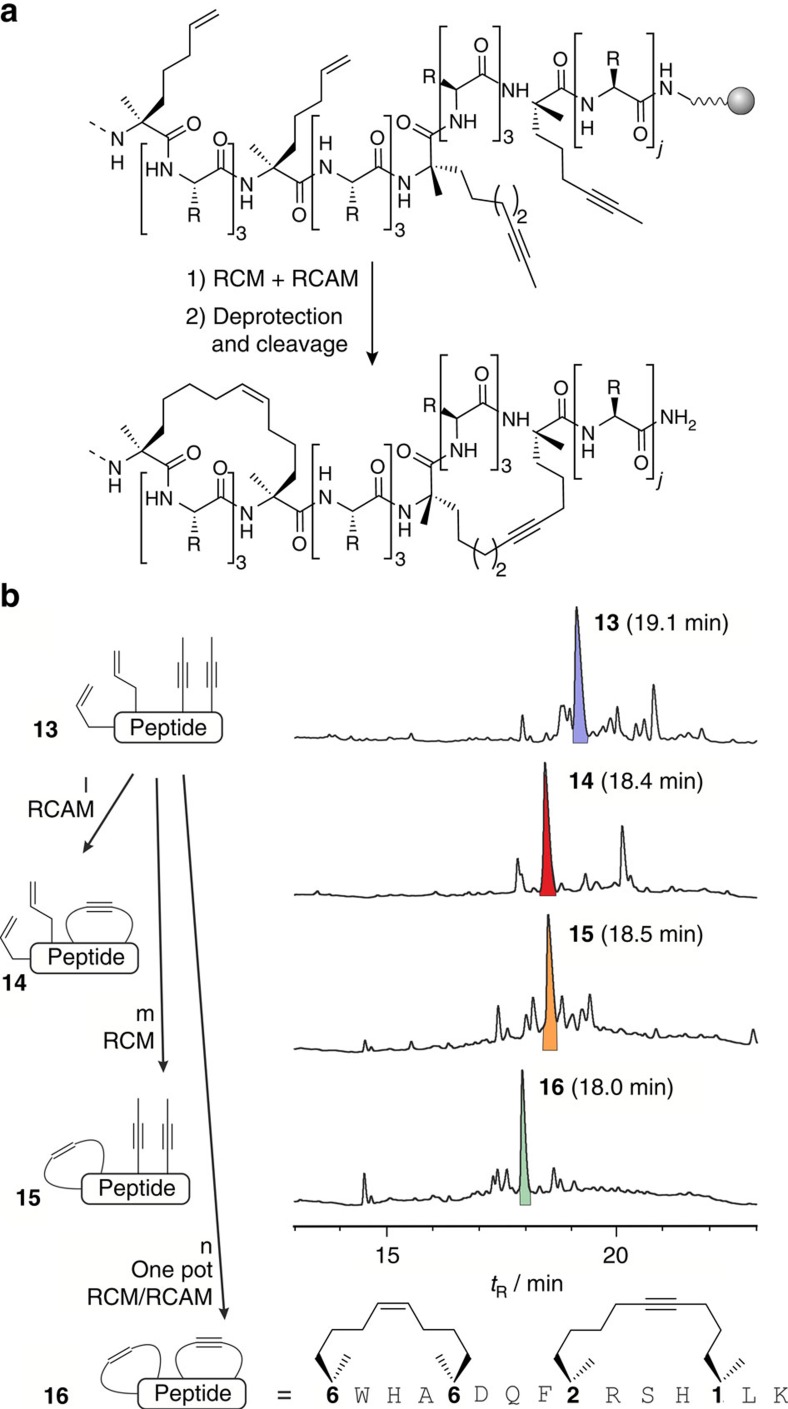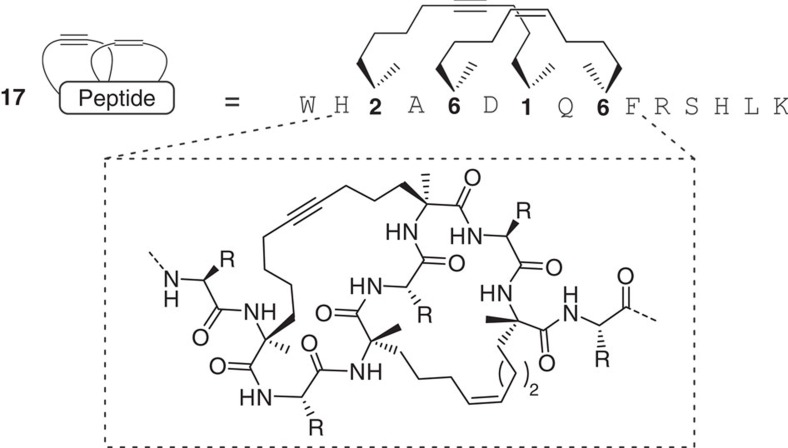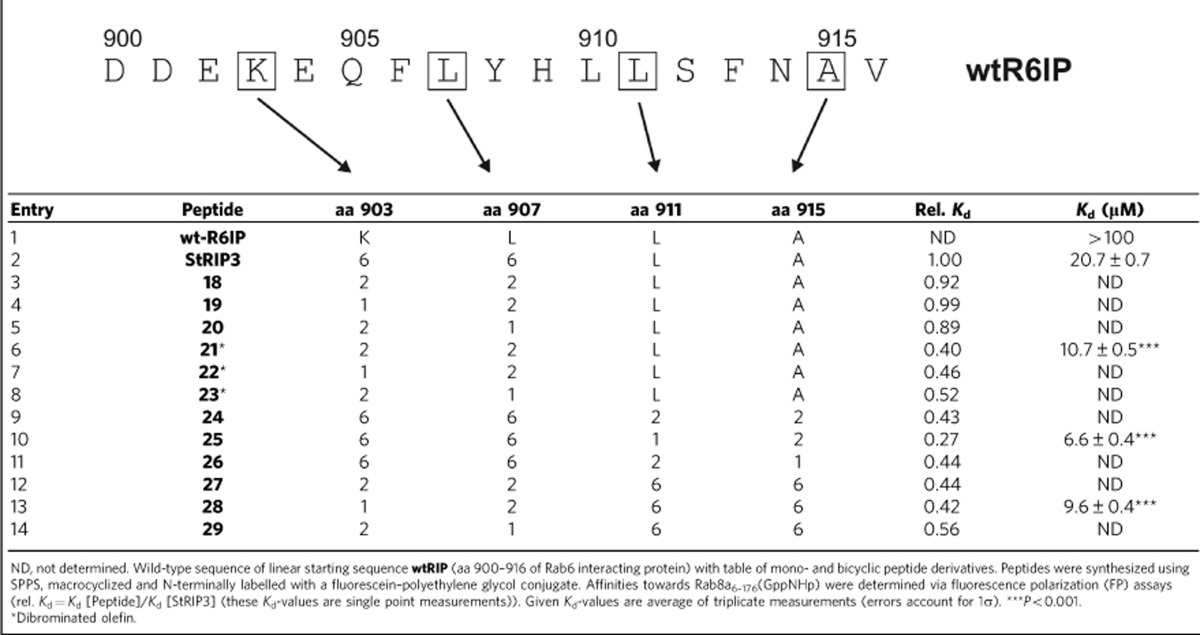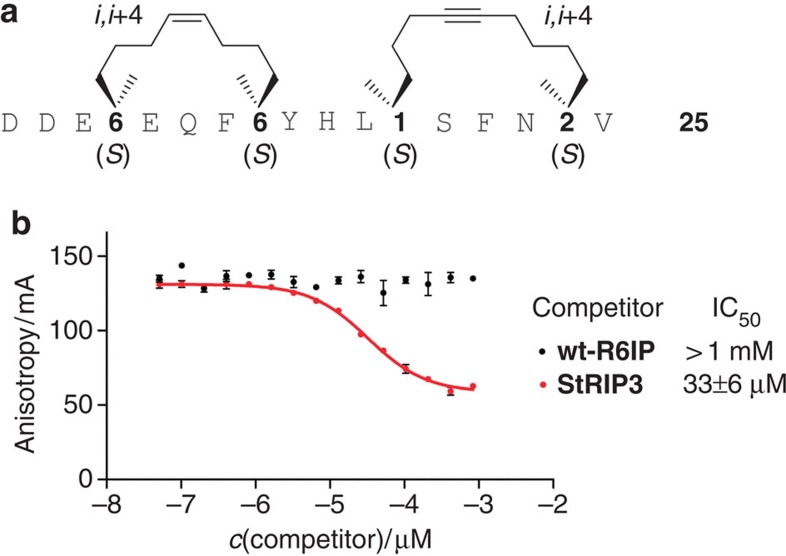Abstract
Bicyclic peptides are promising scaffolds for the development of inhibitors of biological targets that proved intractable by typical small molecules. So far, access to bioactive bicyclic peptide architectures is limited due to a lack of appropriate orthogonal ring-closing reactions. Here, we report chemically orthogonal ring-closing olefin (RCM) and alkyne metathesis (RCAM), which enable an efficient chemo- and regioselective synthesis of complex bicyclic peptide scaffolds with variable macrocycle geometries. We also demonstrate that the formed alkyne macrocycle can be functionalized subsequently. The orthogonal RCM/RCAM system was successfully used to evolve a monocyclic peptide inhibitor of the small GTPase Rab8 into a bicyclic ligand. This modified peptide shows the highest affinity for an activated Rab GTPase that has been reported so far. The RCM/RCAM-based formation of bicyclic peptides provides novel opportunities for the design of bioactive scaffolds suitable for the modulation of challenging protein targets.
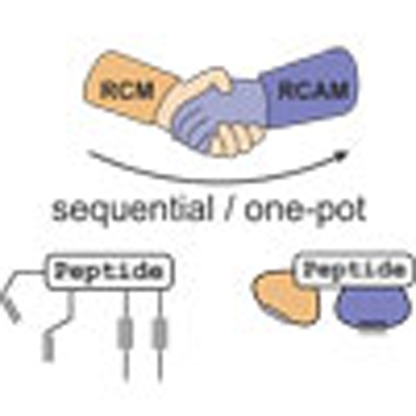 Bicyclic peptides can inhibit biological targets hard to address with small molecules. Here, the authors combine two orthogonal ring-closing reactions to produce bicyclic peptides with improved bioactivity thereby providing a strategy that can greatly improve the structural diversity of such peptides.
Bicyclic peptides can inhibit biological targets hard to address with small molecules. Here, the authors combine two orthogonal ring-closing reactions to produce bicyclic peptides with improved bioactivity thereby providing a strategy that can greatly improve the structural diversity of such peptides.
Macrocyclic peptides exhibit unique surface recognition properties and allow the stabilization of bioactive peptide conformations resulting in ligands with increased bioactivity and bioavailability1,2,3,4,5. Such scaffolds already proved useful for the modulation of biological targets which are intractable by typical small molecules, such as transcription factors and small GTPases6,7,8,9,10,11,12. Recently, structurally rigid bicyclic peptides obtained mainly by epitope grafting on disulfide-rich frameworks13,14 or by phage-display screening15,16 have emerged as particularly interesting inhibitor types. Given the potential of this new chemical modality as scaffold for next-generation therapeutics, the development of efficient synthetic methods that enable the introduction of non-natural fragments into peptidic bicycles is in high demand. This is particularly true for approaches that allow the design of scaffolds that go beyond the size of small epitopes.
For the synthesis of monocyclic peptides, a variety of methods is available17,18,19,20,21,22,23,24,25. Notably, in such peptides, the crosslink itself can directly contribute to bioactivity26,27,28. In this respect, hydrocarbon crosslinks formed by ruthenium-catalysed ring-closing olefin metathesis (RCM) proved particularly successful owing to the hydrophobic and inert character of those crosslinks2,29. Prominent examples involve hydrogen bond surrogates8,30,31 and hydrocarbon stapling32,33,34,35, which have provided a number of potent inhibitors of protein—protein interactions2. In these cases, the synthesis of bicyclic architectures requires the presence of multiple olefins, which causes selectivity problems during cyclization36,37. Undesired side reactions can be reduced by the selection of appropriate ring sizes and distances38, by functional group transformations39 and by tedious fine tuning of olefin reactivity39. Thus, only a small set of scaffolds is accessible by multiple RCM reactions36,37,38,39,40. This creates the need for synthesis methods that integrate two consecutive, chemically orthogonal metathesis reactions thereby enabling efficient chemo- and regioselective construction of complex bicyclic peptides. Ideally, such methods would be compatible with solid-phase peptide synthesis (SPPS).
Molybdenum-catalysed ring-closing alkyne metathesis41 (RCAM) shares many of the advantageous properties of RCM, and is in principle chemically orthogonal to ruthenium-catalysed RCM. RCAM has been applied for peptide macrocyclizations in solution42,43,44. However, the synthesis of bicyclic peptides by orthogonal ring-closing olefin and alkyne metathesis has not been explored so far. Here, we report the solid-phase synthesis of bicyclic peptides by means of orthogonal ring-closing olefin- and alkyne-metathesis reactions. We demonstrate that the alkyne macrocycle can be further functionalized selectively. The orthogonal RCM/RCAM system was successfully used to evolve a monocyclic peptide inhibitor of the small GTPase Rab8 into a bicyclic ligand with increased target affinity.
Results
RCAM and functionalization on solid support
To explore RCAM-based macrocyclization of peptides on solid support (Fig. 1a), two α-methyl-α-alkynyl building blocks (1–4) of varying linker length and configuration (Fig. 1b) were introduced into model peptides using Fmoc-based SPPS. Peptide sequences, architectures and relative spacing of non-natural amino acids (i,i+3, i,i+4 and i,i+7) were selected by analogy to previously explored RCM-based peptide macrocyclizations33. As proof-of-concept and to test the robustness of the reaction, we designed model peptides that contain all functionalities present among the 20 proteinogenic amino acids and yield macrocyclic peptides 7–9 after RCAM (Fig. 2a). Investigation of various RCAM conditions including the latest generation of stable Mo-complexes45,46 (Supplementary Table 1) revealed efficient conversions after 3 h at 40 °C in toluene if Tentagel rink amide resin and complex 5 (Fig. 1a) were used (Supplementary Figs 2–5, Supplementary Table 2). Under these conditions, macrocycles were formed for all three architectures (7–9) with the best results obtained for an i,i+4 geometry and a final crosslink of nine carbon atoms (8). Shortening the hydrocarbon bridge from nine to eight carbon atoms reduces the efficiency of the reaction presumably due to increased ring strain (Supplementary Fig. 4).
Figure 1. Alkyne macrocyclization.
(a) The linear peptide is assembled via SPPS including the incorporation of two α-methylated-α-alkynylated building blocks (1–4). The C-terminal building block is always (S)-configured, the configuration of the N-terminal building block varies between the different architectures. Complex 5 is used to perform the RCAM reaction. (i=2, 3, 6, number of amino acids between non-natural building blocks; j=3, 6; m=1, 2, 4; n=1, 2; R=side chain of a proteinogenic amino acid) (b) Fluorenylmethoxycarbonyl (Fmoc) protected non-natural amino acids incorporated into the peptide sequence (alkyne: 1–4, olefin: 6). The alkyne building blocks 1–4 are either used in the (S)- or (R)-configuration depending on the macrocycle architecture. Mo-complex (5) used for RCAM.
Figure 2. Ring-closing alkyne metathesis on solid support.
(a) Sequences of peptides 7–9 containing different macrocylic architectures. (b) Sequence of peptide 10 with non-natural amino acids 1 and 2 at position i and i+4 (nine-carbon crosslink) with corresponding chromatograms of crude reaction mixtures before (10, top) and after RCAM (11, middle) and after dibromination (12, bottom). Corresponding product peaks are highlighted: open (10, blue), closed (11, red) and dibrominated (12, orange) macrocycle. Chromatograms were obtained after deprotection and release of intermediates from the resin. ‘j' represents Complex 5, dry toluene, 40 °C, 2 × 1.5 h; ‘k' represents CuBr2, dry MeCN, 3 × 1 h.
Selective functionalization of the alkyne linker embedded in the macrocycle was achieved, after treatment of macrocyclic peptide 11 with CuBr2 in dry acetonitrile on solid support to yield dibrominated olefin 12 (Fig. 2b). Notably, the reaction can be performed conveniently with different resin-bound peptides (for all tested architectures: i,i+3, i,i+4 and i,i+7) using standard syringe reactors (Supplementary Figs 6–8, Supplementary Table 2). Full conversion in the dibromination reaction is only achieved after multiple treatments with CuBr2 and for peptides that lack the two N-terminal sulfur containing amino acids (Cys and Met).
Bicyclic peptide synthesis via orthogonal RCM and RCAM
To determine whether RCM and RCAM can be performed orthogonally within one peptide sequence (Fig. 3a), peptide 16 was synthesized which embodies two alkyne-functionalized building blocks (1 and 2) in i,i+4-position at the carboxy (C) terminus, and two olefin-containing amino acids (6, Fig. 1b) in i,i+4-position at the amino (N) terminus (Fig. 3b). In peptide 16, an olefin macrocycle can be formed next to an alkyne-bearing macrocycle (Fig. 3b). The treatment of immobilized precursor peptide 13 (blue peak) with either complex 5 or Grubbs first-generation catalyst leads to selective formation of the alkyne (14, red peak) and olefin macrocycle (15, orange peak), respectively (Fig. 3b, Supplementary Figs 9 and 10). HPLC-MS analyses of the alkyne and olefin crosslinked intermediates (14 and 15) reveal highly selective formation of the desired macrocycle without formation of an alternative cyclization product (Supplementary Fig. 10). Both monocycles can be converted into the bicyclic product 16 by means of the second metathesis reaction. This result is remarkable since previous attempts of orthogonal macrocycle formation within peptides failed44, but were successful only for the assembly of simple building blocks47. In an even more demanding set-up, the simultaneous closure of both macrocycles in a one-pot reaction was tested (instead of the previous sequential synthesis). Strikingly, treatment of the open peptide precursor 13 with a mixture of complex 5 and Grubbs first-generation catalyst also yields the desired bicyclic peptide 16 (green peak, Fig. 3b and Supplementary Fig. 10).
Figure 3. Solid phase synthesis of bicyclic peptides by means of the RCM/RCAM method.
(a) General scheme for the synthesis of bicyclic peptides obtained by means of RCM and RCAM of the acyclic precursor peptides. (j=2, number of C-terminal amino acids; R=side chain of a proteinogenic amino acid except Cys or Met). (b) Sequence of bicyclic test peptide 16 bearing an i,i+4 olefin crosslink (eight C-atoms) and an i,i+4 alkyne crosslink (nine C-atoms). Chromatograms of crude reaction mixtures of peptide 16 before macrocyclization (13, top), after RCAM (14, second) and RCM (15, third), respectively, and after simultaneous (one-pot) RCM and RCAM (16, bottom). Corresponding product peaks are highlighted: fully open (13, blue), alkyne monocycle (14, red), olefin monocycle (15, orange) and bicyclic peptide (16, green). Chromatograms were obtained after deprotection and cleavage of resin-bound intermediates. ‘l' represents Complex 5, dry toluene, 40 °C, 2 × 1.5 h; ‘m' represents Grubbs first-generation catalyst, DCE, 3 × 2 h; ‘n' represents Complex 5, Grubbs first-generation catalyst, dry toluene, 40 °C, 2 × 1.5 h.
In peptide 16, the two individual macrocycles are sequentially arranged along the amino acid chain, that is, the two individual macrocycles are linked by a linear amino acid sequence. A synthetically more challenging setup involves the synthesis of two entangled macrocyles resulting in more constrained peptide scaffolds (for example, peptide 17, Fig. 4). In this architecture, an edge-on bimacrocycle structure is generated as opposed to a linear macrocycle arrangement as in peptide 16. Most notably, entangled bicyclic peptide 17 (Fig. 4) was also efficiently formed in both the sequential as well as the one-pot synthesis (Supplementary Figs 11 and 12).
Figure 4. Sequence and chemical structure of the engulfed bicyclic peptide 17.
R, side chain of a proteinogenic amino acid except Cys or Met.
Bicyclic ligands of the small GTPase Rab8
To demonstrate the potential of this robust orthogonal RCM/RCAM macrocyclization, we aimed at the improvement of a monocyclic bioactive peptide targeting a challenging protein. Small GTPases comprise a protein superfamily with clinically highly relevant, yet particularly challenging, drug targets48,49,50,51,52,53,54. Despite enormous efforts, no efficient inhibitors of small GTPases have reached clinical trials. Importantly, the target affinity of small molecule modulators typically does not exceed the low-to-medium micromolar range50,51. Among the small GTPase superfamily, Rab proteins (Ras-related in brain) constitute key regulators of intracellular vesicular transport and trafficking55,56. As starting point for the generation of a bicyclic peptide, we selected the hydrocarbon-stapled monocyclic peptide StRIP3, which binds the small GTPase Rab8a with moderate affinity (dissociation constant (Kd)=20.7 μM, Table 1, entry 2)12. StRIP3 resembles the only known inhibitor of a Rab protein–protein interaction12 and is based on the interaction motif of Rab6-interacting protein 1 (wt-R6IP, Table 1, entry 1)57. Initially, alkyne-bearing macrocycles based on StRIP3 were explored in which the i,i+4 olefin crosslink was replaced by alkynes with varying crosslink length (9–10 carbon atoms, Table 1, entry 3–5). The 10-carbon crosslink requires double incorporation of building block 2 (entry 3). A nine-carbon crosslink is generated by incorporation of two different building blocks (1 and 2), which results in two different architectures (entry 4: 1/2, entry 5: 2/1). The synthesis of an eight-carbon crosslinked StRIP3 derivative containing building block 1 twice was not possible, most likely due to high ring strain caused by the linear geometry of the triple bond.
Table 1. Small GTPase targeting peptides.
In addition, dibrominated (entry 6–8) and bicyclic peptides (entry 9–14) were synthesized resulting in a total of 12 StRIP3 derivatives grouped into four subfamilies (Table 1, Supplementary Table 3): (i) alkyne mono-macrocyclic peptides 18–20 (entry 3–5); (ii) dibrominated olefin macrocyclic peptides 21–23 (entry 6–8); (iii) orthogonally macrocyclized peptides 24–26 carrying the original olefin crosslink and an additional alkyne crosslink at the C terminus (entry 9–11); and (iv) bicyclic peptides 27–29 with exchanged positions for the alkyne and the olefin crosslink (entry 12–14). Since the N-terminal part of parent peptide StRIP3 is already constrained by the olefin macrocycle, we aimed for the introduction of a new macrocycle in the C-terminal part. We reasoned that additional constraint could further stabilize the bioactive peptide conformation. Owing to a lack of structural information, it is not obvious which amino acids are directly involved in Rab-binding. For this reason, we selected two amino acids with hydrophobic side chains (L911 and A915) for macrocycle introduction as their non-polar side chains are potentially mimicked by the hydrocarbon macrocycle. All the peptides were synthesized via SPPS and modified with an N-terminal fluorescein–polyethyleneglycol label (Supplementary Table 3) to enable determination of their binding affinity towards activated Rab8a6-176(GppNHp) in a fluorescence polarization (FP) assay (Supplementary Fig. 13). After initial ranking of the peptides by means of relative Kd values (rel. Kd, Table 1, Supplementary Table 4), the affinity of the best binders (peptide 21, 25 and 28) was determined in an independent FP assay run in triplicates (Table 1, Supplementary Fig. 14). Replacement of the olefin by an alkyne crosslink yields peptides 18–20 with affinities comparable to StRIP3. In contrast, the dibrominated olefin derivatives 21–23 show improved affinity towards Rab8a6–176 with peptide 21 being the most potent binder within this subfamily (Kd=10.7 μM, Table 1). Peptide 21 shows a 2-fold increased binding affinity when compared with StRIP3. Notably, an even higher improvement in binding affinity to Rab8a6–176(GppNHp) is observed for two of the bicyclic peptides 24–29, namely peptide 25 and 28 (Table 1 and Supplementary Table 4). In both the cases, the nine-carbon alkyne crosslink (with 1 at N-terminal and 2 at C-terminal position within the sequence) provides the most potent architecture resulting in two significantly improved ligands for activated Rab8a6–176 (Kd[25]=6.6 μM; Kd[28]=9.6 μM). Bicyclic peptide 25 (Fig. 5a) is more than three times more potent than the parent hydrocarbon stapled peptide StRIP3 and displays a more than 15-fold increased binding affinity compared with the unmodified wild-type peptide wt-R6IP. Binding affinity of peptide 25 was confirmed in microscale thermophoresis measurements. On the basis of fluorescence intensity, an affinity for Rab8a6–176(GppNHp) was observed (Kd[25]=11 μM, Supplementary Table 5, Supplementary Figs 15 and 16), which is in the range of our FP measurements (Kd[25]=6.6 μM, see above). In addition, FP competition experiments were performed using a complex between labelled peptide 25 and Rab8a6–176(GppNHp), which was treated with an excess of acetylated StRIP3. In this setup, we observed full displacement of peptide 25 (IC50=33 μM, red Fig. 5b). As one would expect, the acetylated low-affinity peptide wt-R6IP does not compete with peptide 25 (black, Fig. 5b). These results verify reversible binding of peptide 25 to the same site on Rab8 as parent peptide StRIP3.
Figure 5. Sequence and binding studies of peptide 25.
(a) Sequence of bicyclic peptide 25 showing highest affinity for Rab8a6–176(GppNHp). (b) Competition of fluorescein-labelled peptide 25 (60 nM) bound to Rab8a(GppNHp; 15 μM) with increasing concentrations of acetylated peptides StRIP3 and wt-R6IP (competitors). Errors represent 1σ of triplicates.
Discussion
We identified conditions that enable the performance of RCAM reactions in conjunction with SPPS allowing alkyne-based macrocyclization of peptide sequences involving all natural side-chain functionalities. Subsequent functionalization of the alkyne allows further modification of the macrocycle, which opens new perspectives in the design of macrocyclic scaffolds. In addition, we report the chemo- and regioselective synthesis of bicyclic peptides bearing an alkyne as well as an olefin crosslink accessible via orthogonal ring-closing olefin and alkyne metathesis on solid support. This approach allows direct control of the individual macrocyclization reaction and enables the formation of bicyclic peptides with novel architectures combining two different macrocycles within the same peptide sequence. The applicability of such scaffolds for highly challenging targets, such as small GTPases, was demonstrated via identification of the currently most potent binder of an activated Rab GTPase (peptide 25, Kd=6.6 μM). Since the bioactivity of a peptide is mainly determined by its secondary structure1,2, alkyne macrocyclization and the orthogonal introduction of bicyclic alkyne/olefin macrocycles within the same peptide sequence give rise to novel constrained peptide architectures with high potential for the targeting of currently intractable proteins.
Methods
General
For abbreviations and detailed information about the experimental procedures, analytical data and FP binding curves, see Supplementary Figs 1–16, Supplementary Tables 1–5, Supplementary Note 1 and Supplementary Methods.
Synthesis of building blocks 1–4
Synthesis of the Fmoc protected building blocks 1–4 was performed according to adapted protocols using Ni(II)-BPB ((R/S)-2-[N-(N′-benzylpropyl)amino]benzophenone) complexes58,59. For a detailed description of building block synthesis and analytical data, see Supplementary Methods.
Peptide synthesis
Peptides were synthesized according to standard Fmoc-chemistry for SPPS using HCTU (O-(6-chlorobenzotriazol-1-yl)-N,N,N′,N′-tetramethyluronium hexafluorophosphate) and COMU (1-[(1-(cyano-2-ethoxy-2-oxoethylidenaminooxy)-dimethylaminomorpholino)]-uronium hexafluorophosphate) as coupling reagents (Supplementary Fig. 1). For more detailed information about peptide synthesis, see Supplementary Methods and Supplementary Tables 2 and 3.
Ring-closing alkyne metathesis
The dried resin was swollen and shrunken under argon alternating in dry diethyl ether and dry toluene (3 × each). Afterwards 0.5 ml of a solution of the alkyne-metathesis complex 5 (2 mg ml−1) in dry toluene was added and the reaction mixture was stirred at 40 °C for 1.5 h. During the reaction time, argon was bubbled through the reaction mixture to evaporate the 2-butyne. After addition of 0.5 ml of fresh complex 5 solution, the mixture was stirred at 40 °C for 1.5 h.
Ring-closing olefin metathesis
The dried resin was swollen in 1,2-dichloroethane (DCE) for 15 min. Subsequently, 0.5 ml of a solution of Grubbs first-generation catalyst (2 mg ml−1) in DCE was added to the resin and reacted for 2 h at room temperature. During the reaction time, argon was bubbled through the reaction mixture to remove ethene. The procedure was repeated twice.
One-pot ring-closing alkyne and olefin metathesis
The dried resin was swollen and shrunken under argon alternating in dry diethyl ether and dry toluene (3 × each). Afterwards 0.5 ml of a solution of the alkyne-metathesis complex 5 (2 mg ml−1) and Grubbs first-generation catalyst (2 mg ml−1) in dry toluene was added and the reaction mixture stirred at 40 °C for 1.5 h. During the reaction time, argon was bubbled through the reaction mixture to evaporate 2-butyne and ethene. After the addition of 0.5 ml of fresh complex solution (alkyne complex 5 and Grubbs first-generation catalyst), the mixture was stirred at 40 °C for 1.5 h.
Dibromination of alkyne macrocycles
The dried resin was swollen in dry MeCN for 15 min and treated with a mixture of CuBr2 in dry MeCN (2 mg ml−1) for 2 h. The reaction was performed in a Syringe reactor and the procedure was repeated twice.
Protein expression and purification
The expression and purification of Rab8a6–176 was performed by analogy to full-length Rab8a according to established protocols60,61.
Nucleotide exchange
Nucleotide exchange was performed according to previously established protocols60,62. Briefly, for nucleotide removal, Mg2+ was removed by the addition of a 5-fold excess of EDTA and reacted for 1 h at room temperature. The protein solution was desalted using a PD-10 desalting column Sephadex G-25 DNA Grade (GE Healthcare) with elution buffer consisting of 20 mM HEPES (pH 7.5), 50 mM NaCl, 1 mM TCEP. After removal of Mg2+, the protein was diluted to 80–100 μM before the addition of ZnCl2 (500 μM) and (NH4)2SO4 (200 mM). After the addition of alkaline phosphatase (5 U mg−1Rab protein), the mixture was incubated for 16 h at 4 °C. For nucleotide exchange, the mixture contained a 5-fold excess of GppNHp during alkaline phosphatase incubation. Afterwards, the mixture was desalted using a PD-10 desalting column Sephadex G-25 DNA Grade (GE Healthcare) with elution buffer consisting of 25 mM HEPES (pH 7.5) 150 mM NaCl, 1 mM TCEP, 1 mM MgCl2 and 1 μM GppNHp.
Fluorescence polarization assay
Rab8a6–176(GppNHp) was serially diluted in a buffer containing 25 mM HEPES (pH 7.5), 150 mM NaCl, 1 mM MgCl2, 1 mM TCEP, 0.01% Tween 20 and 1 μM GppNHp, treated with 66 nM fluorescein-labelled peptides and incubated for 4 h at room temperature. Fluorescence polarization values (λex=470 nm, λem=525 nm) were determined at room temperature. Initial studies for alkyne macrocyclized peptides were performed as single measurements. Final affinity measurements of a subset of peptides were performed in triplicates. After correction for changes in fluorescence intensity upon binding, the fluorescence anisotoropy data were converted into fraction bound of the FITC-labelled peptide and fitted to a one-site binding model derived from the law of mass action using Kd as the only fitting parameter (for details, see Supplementary Methods)63. Nonlinear regression was performed in Prism 5.0 (Graphpad)64.
Competition fluorescence polarization assay
Acetylated peptides were serially diluted and incubated with a mixture of the fluorescein-labelled peptide and Rab8a6–176 (GppNHp) at room temperature for 1 h. Fluorescence polarization was determined and IC50 values were calculated by nonlinear regression analysis using Prism 5.0 software (GraphPad)64.
Additional information
How to cite this article: Cromm, P. M. et al. Orthogonal ring-closing alkyne and olefin metathesis for the synthesis of small GTPase-targeting bicyclic peptides. Nat. Commun. 7:11300 doi: 10.1038/ncomms11300 (2016).
Supplementary Material
Supplementary Figures 1-16, Supplementary Tables 1-5, Supplementary Note 1, Supplementary Methods and Supplementary References
Acknowledgments
We thank N. Bleiming for protein expression/purification and technical assistance. P.M.C. is grateful to the Studienstiftung des Deutschen Volkes for a Fellowship. S.S. and J.S. acknowledge financial support by the Fonds der Chemischen Industrie. T.N.G. thanks the Deutsche Forschungsgemeinschaft (Emmy Noether program GR3592/2-1), AstraZeneca, Bayer CropScience, Bayer HealthCare, Boehringer Ingelheim, Merck KGaA and the Max-Planck Society for their support.
Footnotes
Author contributions P.M.C. designed and carried out the building block synthesis, peptide synthesis, as well as FP assays and analysed the data. S.S. supported alkyne-metathesis reactions and analysed the data. J.S. supported the design and performance of experiments. A.F., T.N.G. and H.W. designed the experiments and supervised the project. All the authors discussed the results and commented on the manuscript. P.M.C., T.N.G. and H.W. wrote the manuscript.
References
- Bock J. E., Gavenonis J. & Kritzer J. A. Getting in shape: controlling peptide bioactivity and bioavailability using conformational constraints. ACS Chem. Biol. 8, 488–499 (2013). [DOI] [PMC free article] [PubMed] [Google Scholar]
- Pelay-Gimeno M., Glas A., Koch O. & Grossmann T. N. Structure-based design of inhibitors of protein-protein interactions: mimicking peptide binding epitopes. Angew. Chem. Int. Ed. 54, 8896–8927 (2015). [DOI] [PMC free article] [PubMed] [Google Scholar]
- Hill T. A., Shepherd N. E., Diness F. & Fairlie D. P. Constraining cyclic peptides to mimic protein structure motifs. Angew. Chem. Int. Ed. 53, 13020–13041 (2014). [DOI] [PubMed] [Google Scholar]
- Mas-Moruno C., Rechenmacher F. & Kessler H. Cilengitide: the first anti-angiogenic small molecule drug candidate. design, synthesis and clinical evaluation. Anticancer Agents Med. Chem. 10, 753–768 (2010). [DOI] [PMC free article] [PubMed] [Google Scholar]
- Srinivas N. et al. Peptidomimetic antibiotics target outer-membrane biogenesis in Pseudomonas aeruginosa. Science 327, 1010–1013 (2010). [DOI] [PubMed] [Google Scholar]
- Leshchiner E. S. et al. Direct inhibition of oncogenic KRAS by hydrocarbon-stapled SOS1 helices. Proc. Natl Acad. Sci. USA 112, 1761–1766 (2015). [DOI] [PMC free article] [PubMed] [Google Scholar]
- Moellering R. E. et al. Direct inhibition of the NOTCH transcription factor complex. Nature 462, 182–188 (2009). [DOI] [PMC free article] [PubMed] [Google Scholar]
- Patgiri A., Yadav K. K., Arora P. S. & Bar-Sagi D. An orthosteric inhibitor of the Ras-Sos interaction. Nat. Chem. Biol. 7, 585–587 (2011). [DOI] [PMC free article] [PubMed] [Google Scholar]
- Grossmann T. N. et al. Inhibition of oncogenic Wnt signaling through direct targeting of β-catenin. Proc. Natl Acad. Sci. USA 109, 17942–17947 (2012). [DOI] [PMC free article] [PubMed] [Google Scholar]
- Upadhyaya P. et al. Inhibition of Ras signaling by blocking Ras-effector interactions with cyclic peptides. Angew. Chem. Int. Ed. 54, 7602–7606 (2015). [DOI] [PMC free article] [PubMed] [Google Scholar]
- Giordanetto F. & Kihlberg J. Macrocyclic drugs and clinical candidates: what can medicinal chemists learn from their properties? J. Med. Chem. 57, 278–295 (2014). [DOI] [PubMed] [Google Scholar]
- Spiegel J. et al. Direct targeting of Rab-GTPase-effector interactions. Angew. Chem. Int. Ed. 53, 2498–2503 (2014). [DOI] [PubMed] [Google Scholar]
- Northfield S. E. et al. Disulfide-rich macrocyclic peptides as templates in drug design. Eur. J. Med. Chem. 77, 248–257 (2014). [DOI] [PubMed] [Google Scholar]
- Poth A. G., Chan L. Y. & Craik D. J. Cyclotides as grafting frameworks for protein engineering and drug design applications. Biopolymers 100, 480–491 (2013). [DOI] [PubMed] [Google Scholar]
- Heinis C., Rutherford T., Freund S. & Winter G. Phage-encoded combinatorial chemical libraries based on bicyclic peptides. Nat. Chem. Biol. 5, 502–507 (2009). [DOI] [PubMed] [Google Scholar]
- Baeriswyl V. & Heinis C. Polycyclic peptide therapeutics. Chem. Med. Chem. 8, 377–384 (2013). [DOI] [PubMed] [Google Scholar]
- White C. J. & Yudin A. K. Contemporary strategies for peptide macrocyclization. Nat. Chem. 3, 509–524 (2011). [DOI] [PubMed] [Google Scholar]
- Montalbetti C. A. & Falque V. Amide bond formation and peptide coupling. Tetrahedron 61, 10827–10852 (2005). [Google Scholar]
- Góngora-Benítez M., Tulla-Puche J. & Albericio F. Multifaceted roles of disulfide bonds. peptides as therapeutics. Chem. Rev. 114, 901–926 (2014). [DOI] [PubMed] [Google Scholar]
- Assem N., Ferreira D. J., Wolan D. W. & Dawson P. E. Acetone-linked peptides: a convergent approach for peptide macrocyclization and labeling. Angew. Chem. Int. Ed. 54, 8665–8668 (2015). [DOI] [PMC free article] [PubMed] [Google Scholar]
- Wang Y. & Chou D. H.-C. A thiol-ene coupling approach to native peptide stapling and macrocyclization. Angew. Chem. Int. Ed. 54, 10931–10934 (2015). [DOI] [PubMed] [Google Scholar]
- Lau Y. H., Andrade P., de McKenzie G. J., Venkitaraman A. R. & Spring D. R. Linear aliphatic dialkynes as alternative linkers for double-click stapling of p53-derived peptides. ChemBioChem. 15, 2680–2683 (2014). [DOI] [PubMed] [Google Scholar]
- Lau Y. H. et al. Double strain-promoted macrocyclization for the rapid selection of cell-active stapled peptides. Angew. Chem. Int. Ed. 54, 15410–15413 (2015). [DOI] [PMC free article] [PubMed] [Google Scholar]
- Mendive-Tapia L. et al. New peptide architectures through C-H activation stapling between tryptophan-phenylalanine/tyrosine residues. Nat. Commun. 6, 7160 (2015). [DOI] [PMC free article] [PubMed] [Google Scholar]
- Lau Y. H., Andrade P., de Wu Y. & Spring D. R. Peptide stapling techniques based on different macrocyclisation chemistries. Chem. Soc. Rev. 44, 91–102 (2015). [DOI] [PubMed] [Google Scholar]
- Baek S. et al. Structure of the stapled p53 peptide bound to Mdm2. J. Am. Chem. Soc. 134, 103–106 (2012). [DOI] [PubMed] [Google Scholar]
- Phillips C. et al. Design and structure of stapled peptides binding to estrogen receptors. J. Am. Chem. Soc. 133, 9696–9699 (2011). [DOI] [PubMed] [Google Scholar]
- Glas A. et al. Constrained peptides with target-adapted cross-links as inhibitors of a pathogenic protein-protein interaction. Angew. Chem. Int. Ed. 53, 2489–2493 (2014). [DOI] [PubMed] [Google Scholar]
- Pérez de Vega M. J., García-Aranda M. I. & González-Muñiz R. A role for ring-closing metathesis in medicinal chemistry: mimicking secondary architectures in bioactive peptides. Med. Res. Rev. 31, 677–715 (2011). [DOI] [PubMed] [Google Scholar]
- Wang D., Chen K., Kulp J. L. & Arora P. S. Evaluation of biologically relevant short alpha-helices stabilized by a main-chain hydrogen-bond surrogate. J. Am. Chem. Soc. 128, 9248–9256 (2006). [DOI] [PMC free article] [PubMed] [Google Scholar]
- Mahon A. B. & Arora P. S. End-capped α-helices as modulators of protein function. Drug Discov. Today Technol. 9, e57–e62 (2012). [DOI] [PMC free article] [PubMed] [Google Scholar]
- Cromm P. M., Spiegel J. & Grossmann T. N. Hydrocarbon stapled peptides as modulators of biological function. ACS Chem. Biol. 10, 1362–1375 (2015). [DOI] [PubMed] [Google Scholar]
- Kim Y.-W., Grossmann T. N. & Verdine G. L. Synthesis of all-hydrocarbon stapled α-helical peptides by ring-closing olefin metathesis. Nat. Protoc. 6, 761–771 (2011). [DOI] [PubMed] [Google Scholar]
- Blackwell H. E. & Grubbs R. H. Highly efficient synthesis of covalently cross-linked peptide helices by ring-closing metathesis. Angew. Chem. Int. Ed. 37, 3281–3284 (1998). [DOI] [PubMed] [Google Scholar]
- Schafmeister C. E., Po J. & Verdine G. L. An all-hydrocarbon cross-linking system for enhancing the helicity and metabolic stability of peptides. J. Am. Chem. Soc. 122, 5891–5892 (2000). [Google Scholar]
- Ghalit N., Rijkers D. T. S., Kemmink J., Versluis C. & Liskamp R. M. J. Pre-organization induced synthesis of a crossed alkene-bridged nisin Z DE-ring mimic by ring-closing metathesis. Chem. Commun. 192–194 (2005). [DOI] [PubMed] [Google Scholar]
- Slootweg J. C., Kemmink J., Liskamp R. M. J. & Rijkers D. T. Synthesis and structural characterization of the individual diastereoisomers of a cross-stapled alkene-bridged nisin DE-ring mimic. Org. Biomol. Chem. 11, 7486–7496 (2013). [DOI] [PubMed] [Google Scholar]
- Bird G. H. et al. Hydrocarbon double-stapling remedies the proteolytic instability of a lengthy peptide therapeutic. Proc. Natl Acad. Sci. USA 107, 14093–14098 (2010). [DOI] [PMC free article] [PubMed] [Google Scholar]
- Robinson A. J. et al. Regioselective formation of interlocked dicarba bridges in naturally occurring cyclic peptide toxins using olefin metathesis. Chem. Commun. 28, 4293–4295 (2009). [DOI] [PubMed] [Google Scholar]
- Hilinski G. J. et al. Stitched α-helical peptides via bis ring-closing metathesis. J. Am. Chem. Soc. 136, 12314–12322 (2014). [DOI] [PubMed] [Google Scholar]
- Fürstner A. Alkyne metathesis on the rise. Angew. Chem. Int. Ed. 52, 2794–2819 (2013). [DOI] [PubMed] [Google Scholar]
- Aguilera B. et al. Synthesis of diaminosuberic acid derivatives via ring-closing alkyne metathesis. J. Org. Chem. 66, 3584–3589 (2001). [DOI] [PubMed] [Google Scholar]
- IJsselstijn M. et al. Ring-closing alkyne metathesis mediated synthesis of cyclic β-turn mimetics. Tetrahedron Lett. 45, 4379–4382 (2004). [Google Scholar]
- Ghalit N., Poot A. J., Fürstner A., Rijkers D. T. S. & Liskamp R. M. J. Ring-closing alkyne metathesis approach toward the synthesis of alkyne mimics of thioether A-, B-, C-, and DE-ring systems of the lantibiotic nisin Z. Org. Lett. 7, 2961–2964 (2005). [DOI] [PubMed] [Google Scholar]
- Heppekausen J. et al. Optimized synthesis, structural investigations, ligand tuning and synthetic evaluation of silyloxy-based alkyne metathesis catalysts. Chem. Eur. J. 18, 10281–10299 (2012). [DOI] [PubMed] [Google Scholar]
- Heppekausen J., Stade R., Goddard R. & Fürstner A. Practical new silyloxy-based alkyne metathesis catalysts with optimized activity and selectivity profiles. J. Am. Chem. Soc. 132, 11045–11057 (2010). [DOI] [PubMed] [Google Scholar]
- Burnley J., Jackson W. R. & Robinson A. J. One-pot selective homodimerization/hydrogenation strategy for sequential dicarba bridge formation. J. Org. Chem. 80, 9057–9063 (2015). [DOI] [PubMed] [Google Scholar]
- Wennerberg K., Rossman K. L. & Der C. J. The Ras superfamily at a glance. J. Cell Sci. 118, 843–846 (2005). [DOI] [PubMed] [Google Scholar]
- McCormick F. KRAS as a therapeutic target. Clin. Cancer Res. 21, 1797–1801 (2015). [DOI] [PMC free article] [PubMed] [Google Scholar]
- Spiegel J., Cromm P. M., Zimmermann G., Grossmann T. N. & Waldmann H. Small-molecule modulation of Ras signaling. Nat. Chem. Biol. 10, 613–622 (2014). [DOI] [PubMed] [Google Scholar]
- Cromm P. M., Spiegel J., Grossmann T. N. & Waldmann H. Direct modulation of small GTPase activity and function. Angew. Chem. Int. Ed. 54, 13516–13537 (2015). [DOI] [PubMed] [Google Scholar]
- Stephen A. G., Esposito D., Bagni R. K. & McCormick F. Dragging ras back in the ring. Cancer Cell 25, 272–281 (2014). [DOI] [PubMed] [Google Scholar]
- Ostrem J. M., Peters U., Sos M. L., Wells J. A. & Shokat K. M. K-Ras(G12C) inhibitors allosterically control GTP affinity and effector interactions. Nature 503, 548–551 (2013). [DOI] [PMC free article] [PubMed] [Google Scholar]
- Agola J. O. et al. A competitive nucleotide binding inhibitor: in vitro characterization of Rab7 GTPase inhibition. ACS Chem. Biol. 7, 1095–1108 (2012). [DOI] [PMC free article] [PubMed] [Google Scholar]
- Bhuin T. & Roy J. K. Rab proteins: the key regulators of intracellular vesicle transport. Exp. Cell Res. 328, 1–19 (2014). [DOI] [PubMed] [Google Scholar]
- Hutagalung A. H. & Novick P. J. Role of Rab GTPases in membrane traffic and cell physiology. Physiol. Rev. 91, 119–149 (2011). [DOI] [PMC free article] [PubMed] [Google Scholar]
- Recacha R. et al. Structural basis for recruitment of Rab6-interacting protein 1 to Golgi via a RUN domain. Structure 17, 21–30 (2009). [DOI] [PubMed] [Google Scholar]
- Belokon' Y. N., Tararov V. I., Maleev V. I., Savel‘eva T. F. & Ryzhov M. G. Improved procedures for the synthesis of (S)-2-[N-(N′-benzylprolyl)amino]benzophenone (BPB) and Ni(II) complexes of Schiff's bases derived from BPB and amino acids. Tetrahedron 9, 4249–4252 (1998). [Google Scholar]
- Bird G. H., Crannell W. C. & Walensky L. D. Chemical synthesis of hydrocarbon-stapled peptides for protein interaction research and therapeutic targeting. Curr. Protoc. Chem. Biol. 3, 99–117 (2011). [DOI] [PMC free article] [PubMed] [Google Scholar]
- Hou X. et al. A structural basis for Lowe syndrome caused by mutations in the Rab-binding domain of OCRL1. EMBO J. 30, 1659–1670 (2011). [DOI] [PMC free article] [PubMed] [Google Scholar]
- Bleimling N., Alexandrov K., Goody R. & Itzen A. Chaperone-assisted production of active human Rab8A GTPase in Escherichia coli. Protein Expr. Purif. 65, 190–195 (2009). [DOI] [PubMed] [Google Scholar]
- Simon I., Zerial M. & Goody R. S. Kinetics of interaction of Rab5 and Rab7 with nucleotides and magnesium ions. J. Biol. Chem. 271, 20470–20478 (1996). [DOI] [PubMed] [Google Scholar]
- Huang X. & Aulabaugh A. Application of fluorescence polarization in HTS assays. Methods Mol. Biol. 565, 127–143 (2009). [DOI] [PubMed] [Google Scholar]
- Motulsky H. & Christopoulos A. Fitting Models to Biological Data Using Linear and Nonlinear Regression. A Practical Guide to Curve Fitting Oxford Univ. Press (2004). [Google Scholar]
Associated Data
This section collects any data citations, data availability statements, or supplementary materials included in this article.
Supplementary Materials
Supplementary Figures 1-16, Supplementary Tables 1-5, Supplementary Note 1, Supplementary Methods and Supplementary References



